Executive Summary
New research released at the 2025 POC NOW Summit offers clarity on how Point of Care marketing plays a distinct and valuable role in patient and provider engagement—a channel long seen as impactful, yet rarely supported by large-scale data. As patient journeys become more complex and marketers face increasing pressure to justify investments, the absence of robust, audience-centered data has become a strategic blind spot: one that may have unintentionally limited the use of a high-potential channel. For senior healthcare marketers, the findings prompt a meaningful reassessment. Credible, real-world data now connects POC activity with key moments in care, including treatment initiation and sustained adherence.
That’s what makes this study especially timely. Commissioned by the Point of Care Marketing Association (POCMA) and conducted by Ipsos in February 2025, the research (hereafter “Research”) surveyed 351 healthcare providers and 765 patients across a wide range of care settings and demographic groups. The result is one of the most comprehensive snapshots to date of how audiences encounter and respond to POC content, highlighting not only consistent behavioral patterns, but also important differences among historically underserved populations.
The findings help marketers rethink the role of POC, not just as a mid-funnel reinforcement tactic. Rather, it serves as a strategic touchpoint for patient education, provider alignment, and message design that reflects audience needs and care context. From refining creative based on how different audiences prefer to receive information to identifying optimal engagement contexts, this study offers grounded, practical insight into how to use POC more meaningfully—whether as a standalone approach or as part of a larger omnichannel strategy.
Beyond Brand Awareness: POC's Documented Behavior Change Connection
While many channels promise engagement, Research documents POC has a singular ability to catalyze specific health behaviors that directly impact brand success:
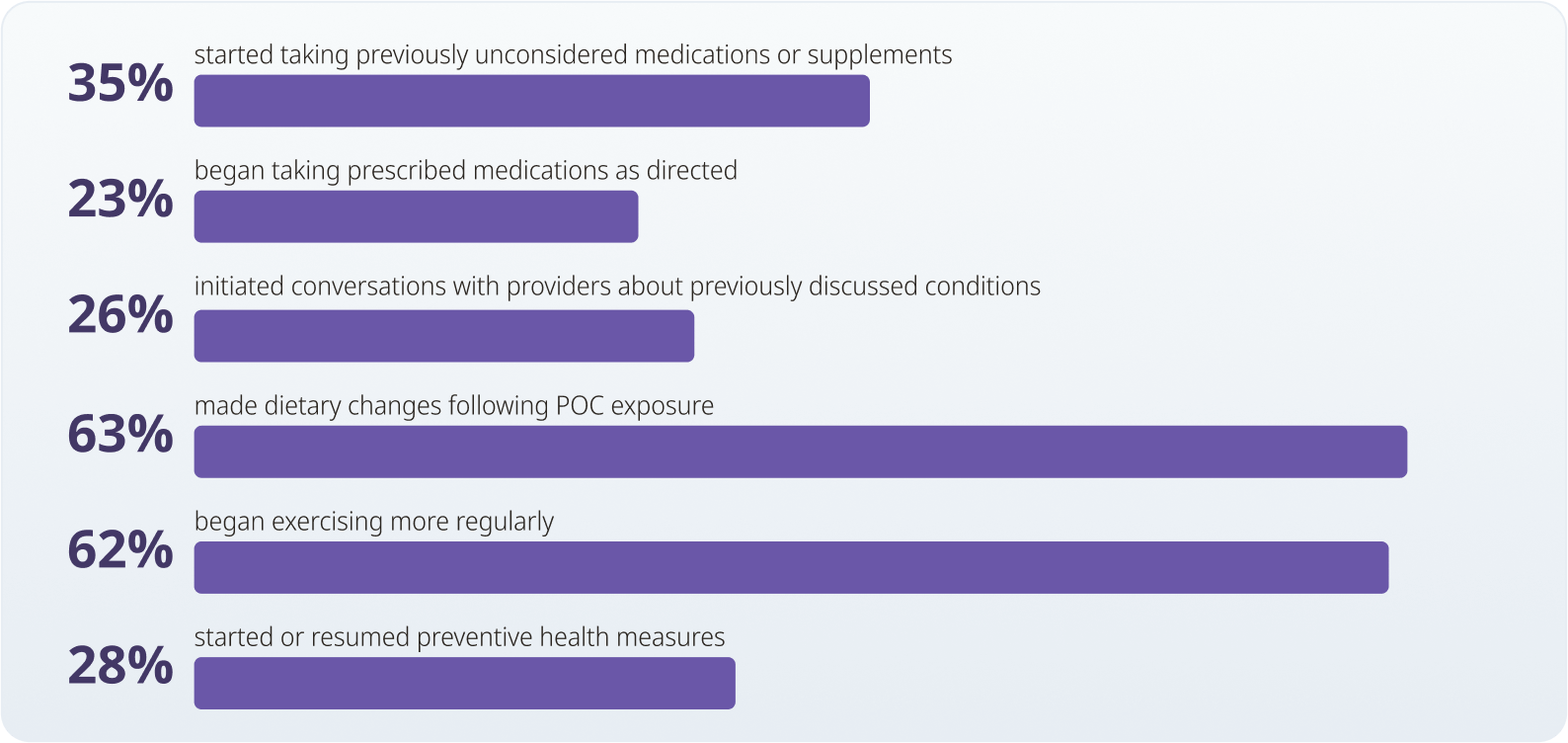
For pharmaceutical marketers, these self-reported behavior changes demonstrate POC's ability to identify and prescribe treatment courses, positively impact patient behavior, support medical advice on lifestyle and health, and ultimately enhance patient outcomes. The direct correlation between POC exposure and medication initiation/adherence creates a compelling case for strategic investment.
The behavior change impact also varies meaningfully across demographic groups, with Black patients reporting higher rates of exercise adoption (72% vs. 62% overall) and Hispanic patients showing higher rates of medication adoption (37% vs. 35% overall)—providing additional targeting insights for condition-specific campaigns.
There’s no single reason POC works—it’s the natural convergence of factors that meet patients in the right moment, in the right way:
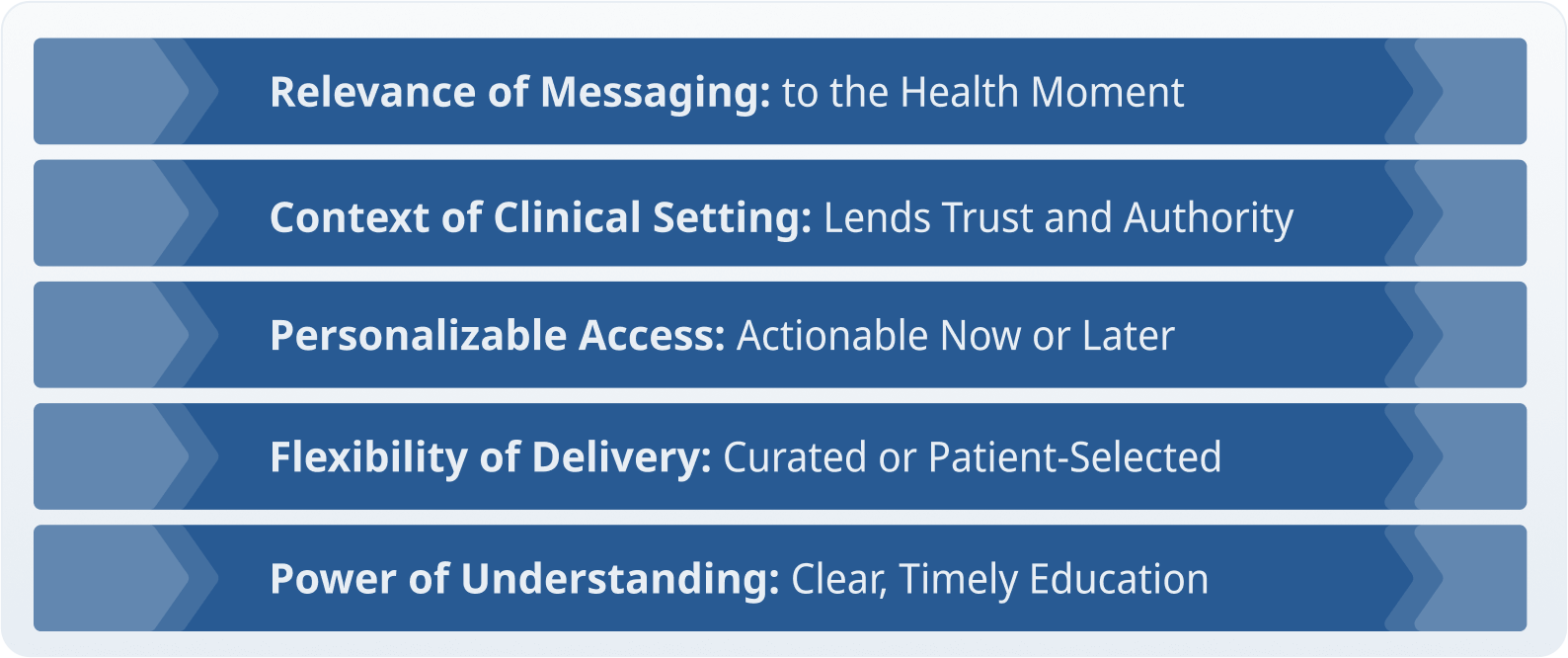
What follows in the data illustrates just how adaptable and strategic POC can be—particularly in areas that are often difficult to reach. This level of responsiveness doesn’t just reduce marketing waste; it can also support more efficient campaigns and improve healthcare delivery.
The Demographic Revelation Healthcare Marketers Can't Ignore
Health equity is often left behind—not out of intention, but because campaigns tend to default to the largest viewership or a one-size-fits-all approach. Yet one of the most actionable insights for healthcare marketers is the dramatic variation in POC engagement across demographic groups:
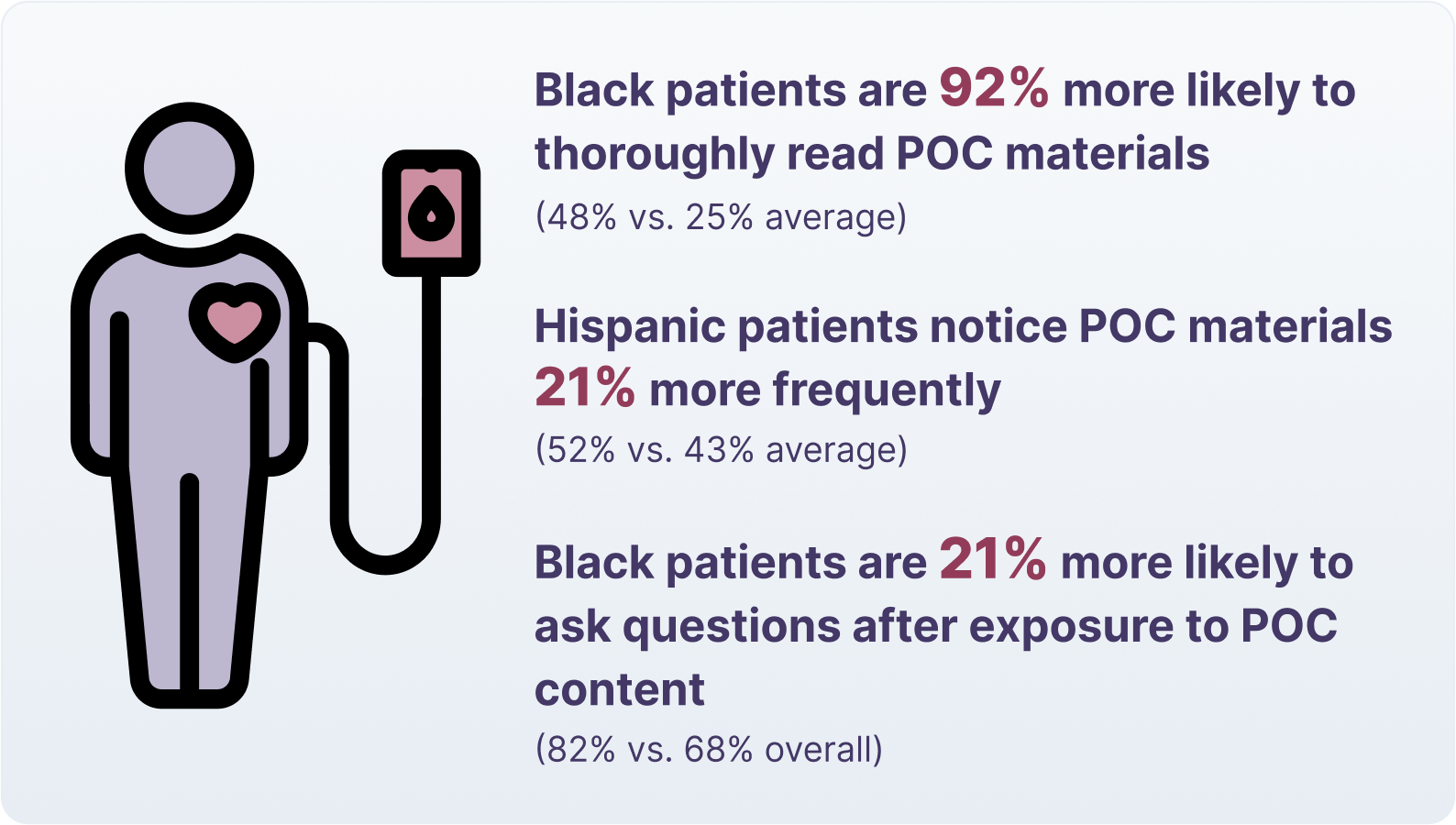
For an industry actively seeking more authentic approaches to health equity, these findings point to a transformative opportunity. POC isn’t just representative—it’s responsive. It reaches people not only through inclusive imagery, but through the inherent strengths of the environment: proximity to care, relevance of timing, and the personal nature of the space itself. And beyond messaging, POC gives brands a strategic pathway to invest directly in the providers and locations that better serve historically underserved communities.
The engagement advantage extends beyond attention into the consultation experience for Blacks and Hispanics, where the data reveals even deeper impacts:

The overall experience and efficacy of healthcare for minority communities can be meaningfully improved—for patients, providers, and the system as a whole. These patterns don’t just suggest a promising channel—they reveal a strategy. Targeted, demographically attuned POC efforts have the power to fill longstanding gaps in health equity initiatives that often stall between intention and measurable impact. And they do so not through abstract virtue signaling, but by meeting people where they are.
The Oncology Gap: Specialized Opportunity Amid Uneven Adoption
The value of Point of Care becomes even more apparent when we look at adoption patterns across specialties, particularly in fields like oncology, where patients face some of the most complex treatment decisions and require careful, stage-appropriate education and support for themselves and their caregivers.
Compounding the gap, 34% of oncologists say existing POC materials oversimplify complex concepts, revealing a mismatch between content design and clinical realities. Striking the right balance between accessibility and clinical relevance requires not only HCP input, but also a deeper understanding of the medical context and the stage-specific educational needs that support true comprehension. Content that reflects this complexity can serve as a bridge, fostering more meaningful conversations between patients and providers and strengthening decision-making at the point of care. One action to achieve this is involving clinicians in the development process to help ensure content supports both patient understanding and provider trust.
This paradox of lower adoption in areas of highest need signals an urgent opportunity. For brands in specialty pharmaceuticals, the challenge isn’t whether POC can work in oncology; it’s how to make it work better.
Interestingly, among oncologists who do use POC, the impact is clear:
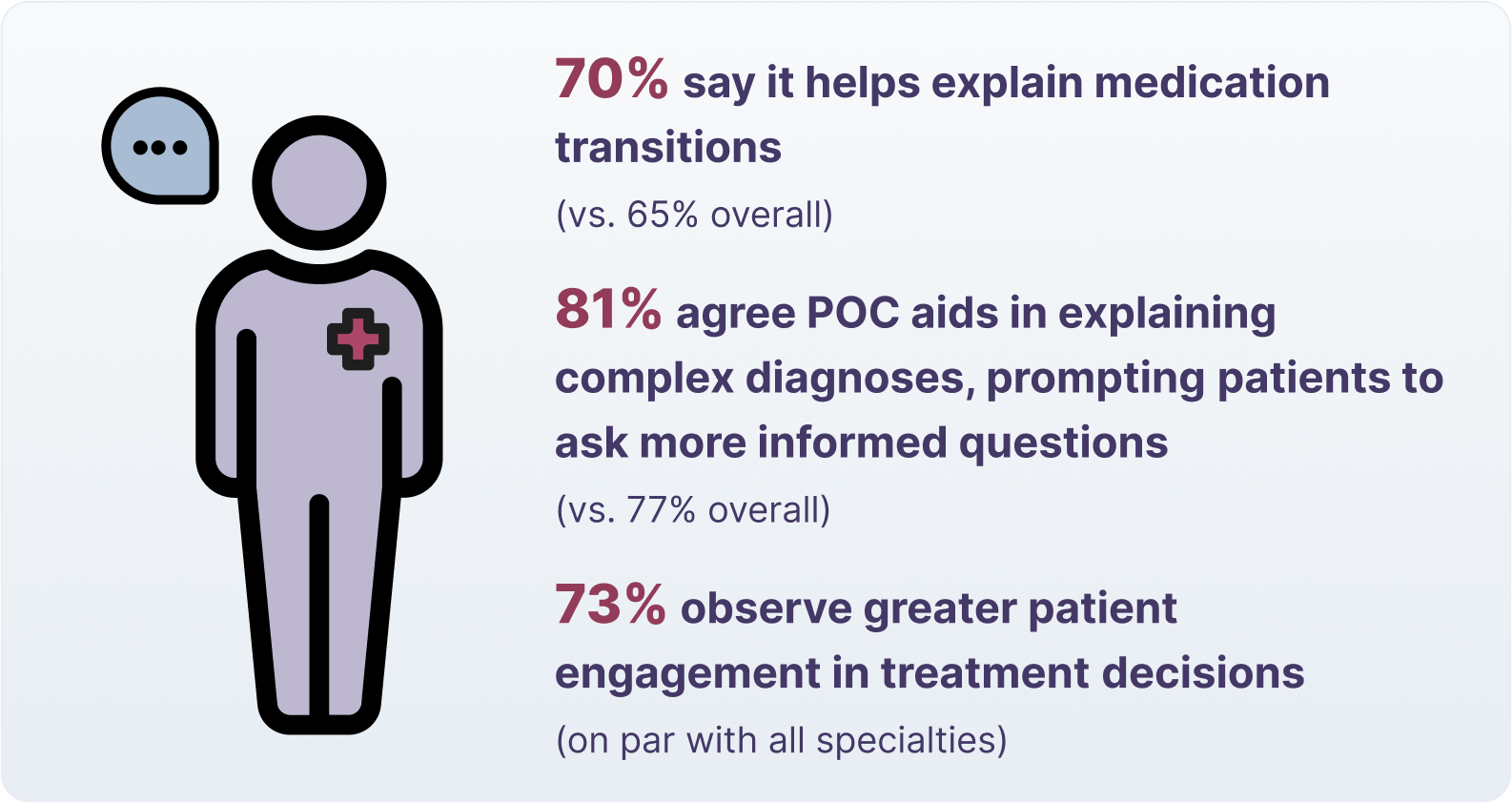
The barrier, then, isn’t efficacy. It’s design and implementation. Oncology requires specialty-specific POC strategies: materials calibrated for clinical nuance, delivered in formats suited to emotionally and cognitively intense conversations, and integrated in ways that complement provider workflow.
By working closely with providers and health systems to understand where the gaps are, and what kind of support patients and caregivers actually need, marketers have an opportunity to transform oncology engagement, not just reinforce it.
The Trust Advantage: POC's Unique Position in the Information Hierarchy
In a landscape crowded with misinformation, conspiracy theories, and influencer “experts,” the demand for credible, trustworthy health information has never been greater. Patients are participating more actively in their care. But self-education only works when the information is reliable and well-placed.
So how do brands build authority? By showing up in places that already have it.
At the Point of Care, trust is built into the environment, and the data reflects it.
When patients ranked health information channels by effectiveness, POC materials came out on top for trust:
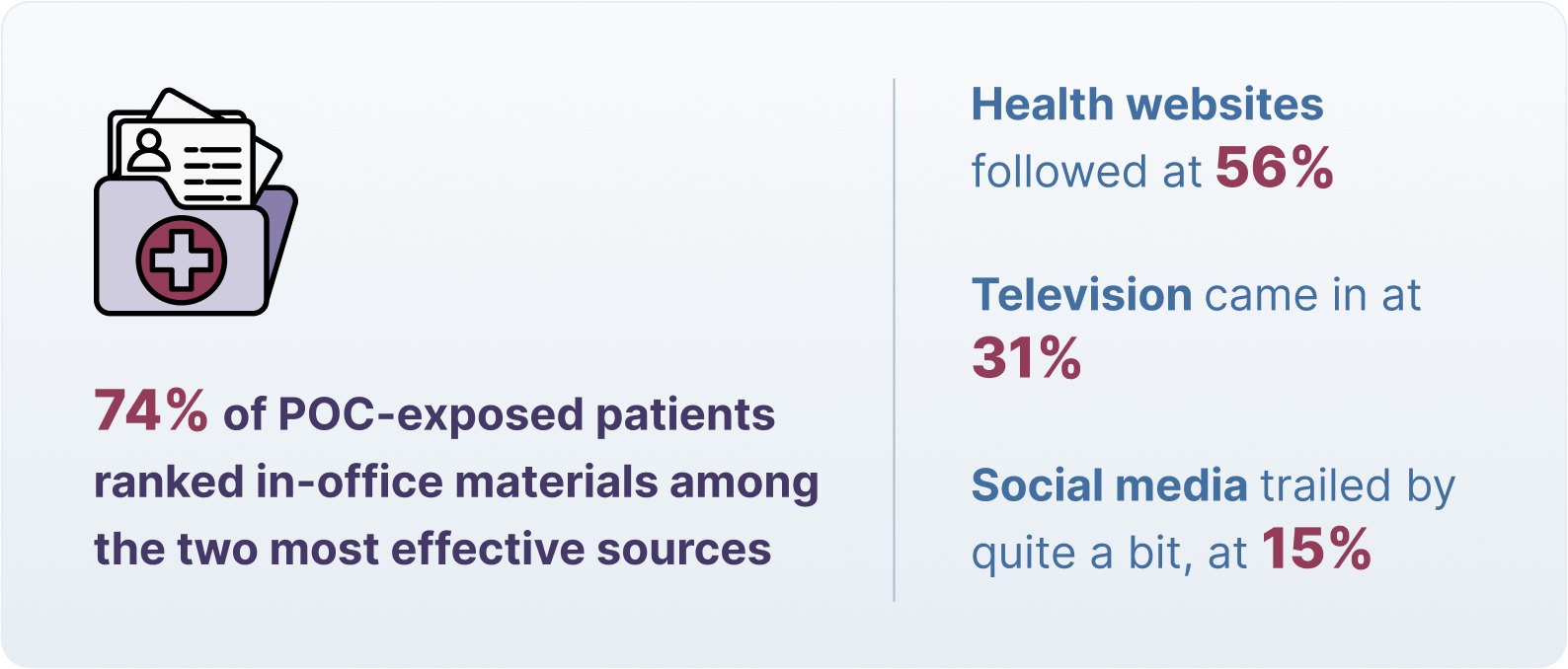
For marketers, this hierarchy should prompt a rethink of channel mix. While digital platforms often consume the lion’s share of budgets, POC continues to outperform in trust, particularly for categories that require deeper education, clinical alignment, or behavioral change.
POC exposure also appears to amplify a patient’s overall engagement with health information:
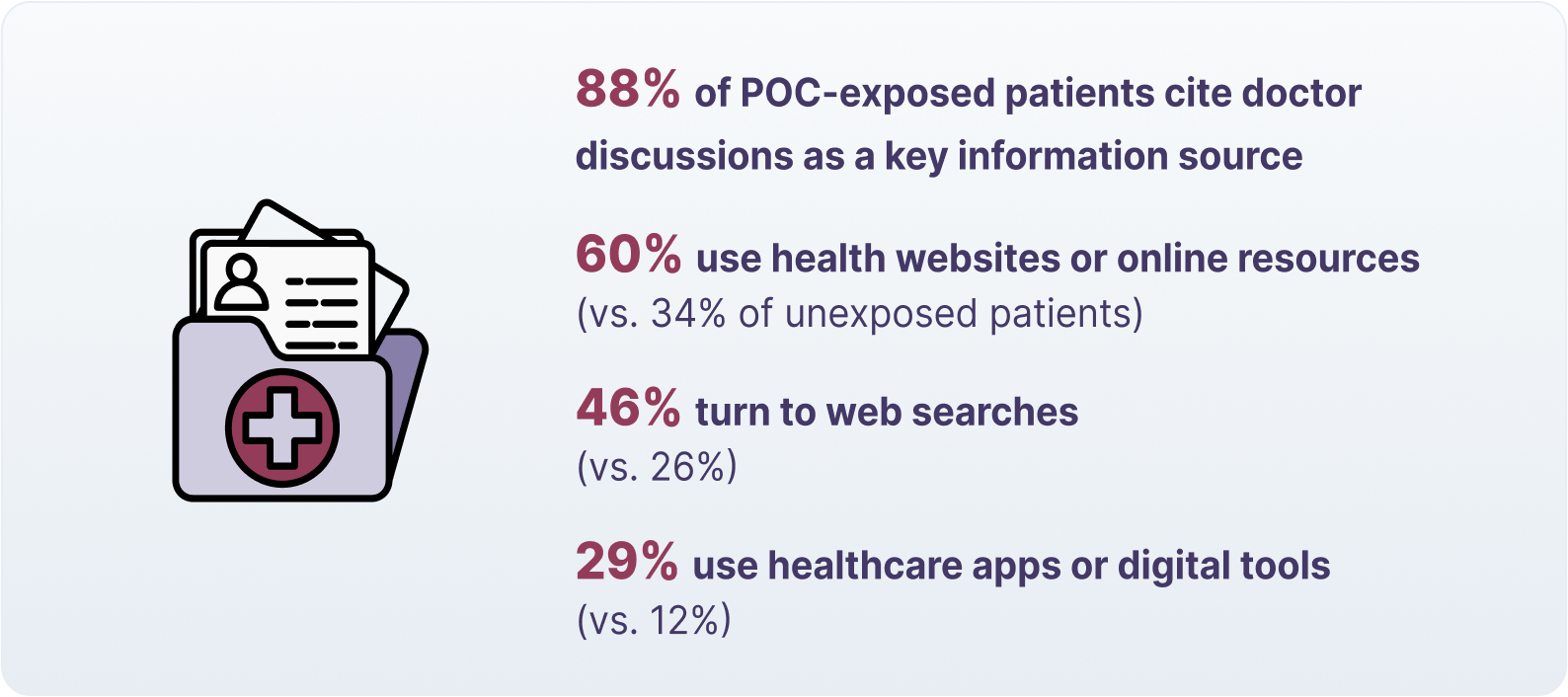
This suggests POC doesn’t compete with other channels—it enhances them. When patients receive meaningful content in trusted environments, it sparks curiosity, questions, and deeper exploration across the ecosystem. In that way, POC may serve not just as a source of education, but as a catalyst for omnichannel engagement and a multiplier for broader marketing strategies.
Provider Perspectives: Why POC Must Serve the Realities of Clinical Care
It may sound obvious, but it’s often overlooked: providers should be central voices in how POC strategies are developed. Whether GP, nurse, specialist, or pharmacist, HCPs understand their patients’ needs, mindsets, and literacy levels. They serve as both advocates and gatekeepers when it comes to health information.
They also have their own needs, needs that POC can help address. From facilitating clearer conversations to encouraging adherence, POC has the potential to improve both the quality of care and how time is spent during consultations.
Providers who use POC report clear benefits:
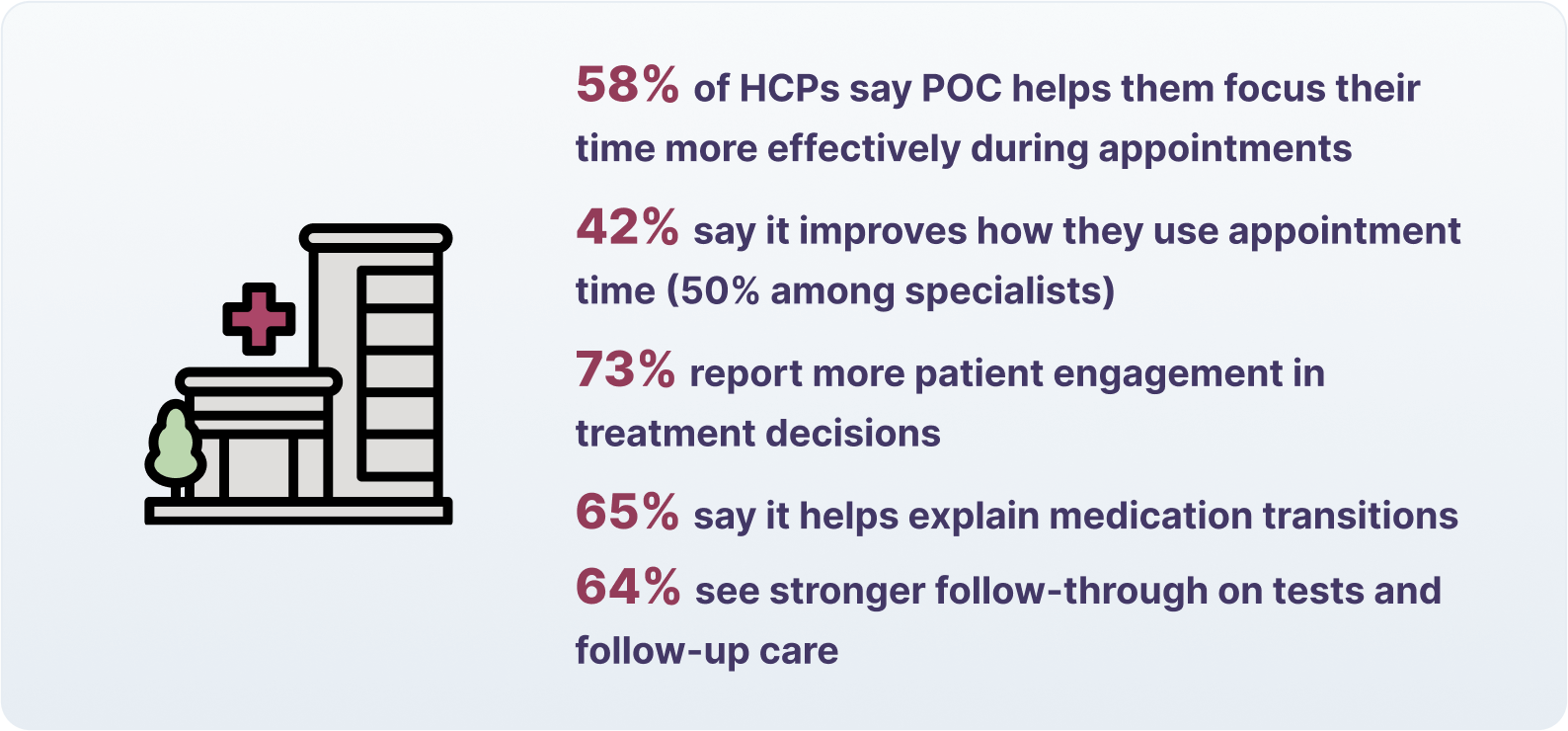
This isn’t about speeding up care. Most providers want more meaningful time with their patients—not less. POC can support clinicians in using the time they have with greater clarity, connection, and confidence. It also helps patients carry the visit with them, reinforcing guidance after the appointment ends.
The benefit is clear, but there are clearly providers not partaking in POC. When asked what influences their adoption of POC tools, providers pointed to both clinical and relational value:
- Patient feedback and requests (59% overall; 63% among oncologists)
- Potential for deeper patient engagement (56% overall; 60% among specialists)
- Evidence of better outcomes (54%)
- Ease of integration into existing workflows (54%)
These insights highlight a central truth: if marketers want providers to adopt POC solutions, they must design with provider realities in mind. That means addressing real-world constraints, listening to provider input, and developing tools that support care teams in delivering informed, compassionate care.
Providers know their patients not just in exam rooms, but within the broader context of their lives, families, and communities. When they are treated as collaborators—not just conduits—POC strategies become more relevant, more sustainable, and more impactful. It’s not just about gaining buy-in. It’s about building solutions that reflect the realities of care, and the people delivering it. Fortunately, what is good for healthcare providers and patients, is also good for your marketing efficacy.
Healthcare Context: POC's Role in Evolving Care Models
Exploring the systemic value of Point of Care further, what benefits patients and providers also strengthens marketing effectiveness. The current healthcare landscape is rapidly changing, and Point of Care is uniquely positioned to move with the tides.
POCMA’s research arrives at a pivotal time, as several converging trends elevate the strategic value of POC:
- Patient expectations are rising, with 45% of POC-exposed patients regularly seeking information beyond provider guidance
- Wellness-oriented care is gaining ground, with 50% of patients wanting preventive or lifestyle-focused content in POC materials
- Health equity efforts are under pressure to deliver measurable impact—not just representative imagery
- Information overload remains a concern, with 41% of providers worried about overwhelming patients
In this environment, POC’s ability to deliver trusted information clearly, connect across diverse populations, and prompt meaningful health behaviors stands out as especially valuable.
No matter how much people move away from traditional healthcare journeys or lean into influencer-driven expertise, the realities of health and wellness remain as nonnegotiable as breath. Finding sources of trust and identifying the right touchpoints for brands to meet patients when they’re actively searching for care, even in new ways, is invaluable.
POC plays a significant role in allaying fears about medicine and healthcare, while also encouraging patient participation in their own care. The research shows a strong emotional benefit tied to POC exposure, with patients reporting greater clarity and confidence:
- 83% of POC-exposed patients feel reassured about their healthcare direction (vs. 76% unexposed)
- 81% feel relieved about having clear next steps (vs. 72%)
- 84% feel motivated to follow doctor recommendations (vs. 76%)
This emotional dimension is often overlooked, but it is critical. Effective POC solutions don’t just inform—they help patients feel guided, supported, and capable. That sense of readiness builds a stronger foundation for adherence, follow-through, and long-term outcomes. Importantly, when done right, POC can extend that informational trust into brand trust.
Design Imperatives: Bridging the Execution Gap
To meet both the opportunity and the times, POC campaigns must adapt. This means building on the trust advantage by becoming more audience-centered, compassionate, and flexible. Strategies should reflect both today’s healthcare expectations and the persistent realities of patient needs.
The research highlights several provider preferences that should inform how POC content is developed and delivered:
- Concise, digestible formats (55% overall; 57% among oncologists)
- Customizable content based on patient demographics (52% overall; 58% among specialists)
- Digital formats that are easy to update (47% overall; 52% among specialists)
- Materials designed for different health literacy levels (34% overall; 41% among oncologists) Printable take-home summaries (66% overall; 72% among specialists)
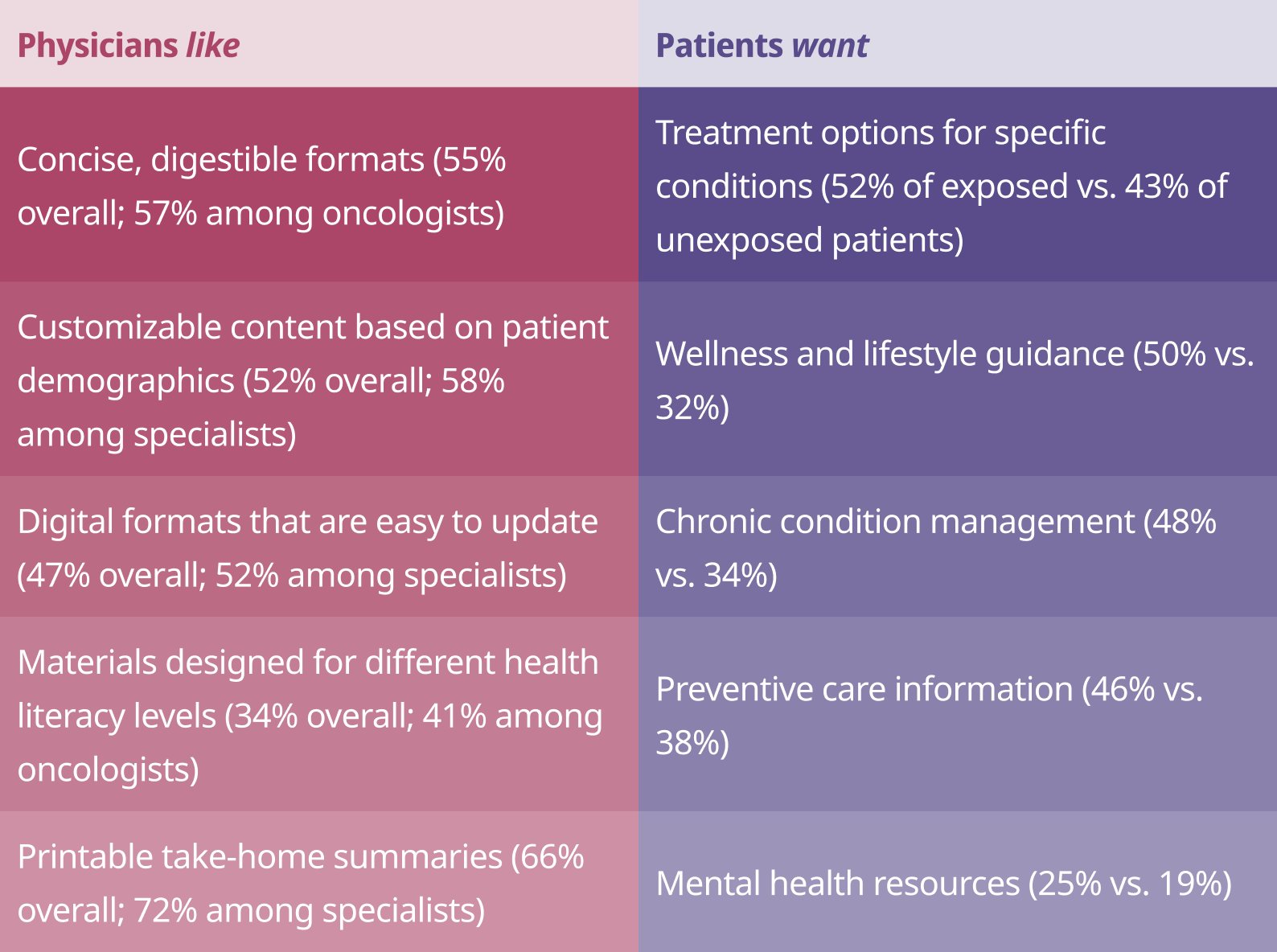
For teams still relying on static, print-heavy approaches, these preferences point to a need for more adaptable formats. The goal is to maintain the reliability of traditional materials while offering the flexibility and responsiveness of digital tools.
Patients also expressed clear preferences around the types of content they find most helpful:
- Treatment options for specific conditions (52% of exposed vs. 43% of unexposed patients)
- Wellness and lifestyle guidance (50% vs. 32%)
- Chronic condition management (48% vs. 34%)
- Preventive care information (46% vs. 38%)
- Mental health resources (25% vs. 19%)
These patterns reveal a growing interest in more holistic, preventative, and everyday forms of health support that go beyond diagnosis or treatment alone. They reveal opportunities for better alignment between what POC content currently offers and what patients are actually looking for. Adapting creative strategies to reflect these priorities with the right formats, topics, and tone in order to allow POC to serve as both an anchor for care and a bridge to stronger health communication.
Strategic Imperatives for Marketing Leaders
Based on the comprehensive findings, several clear imperatives emerge for healthcare marketing leaders seeking to strengthen outcomes and optimize impact at the Point of Care:
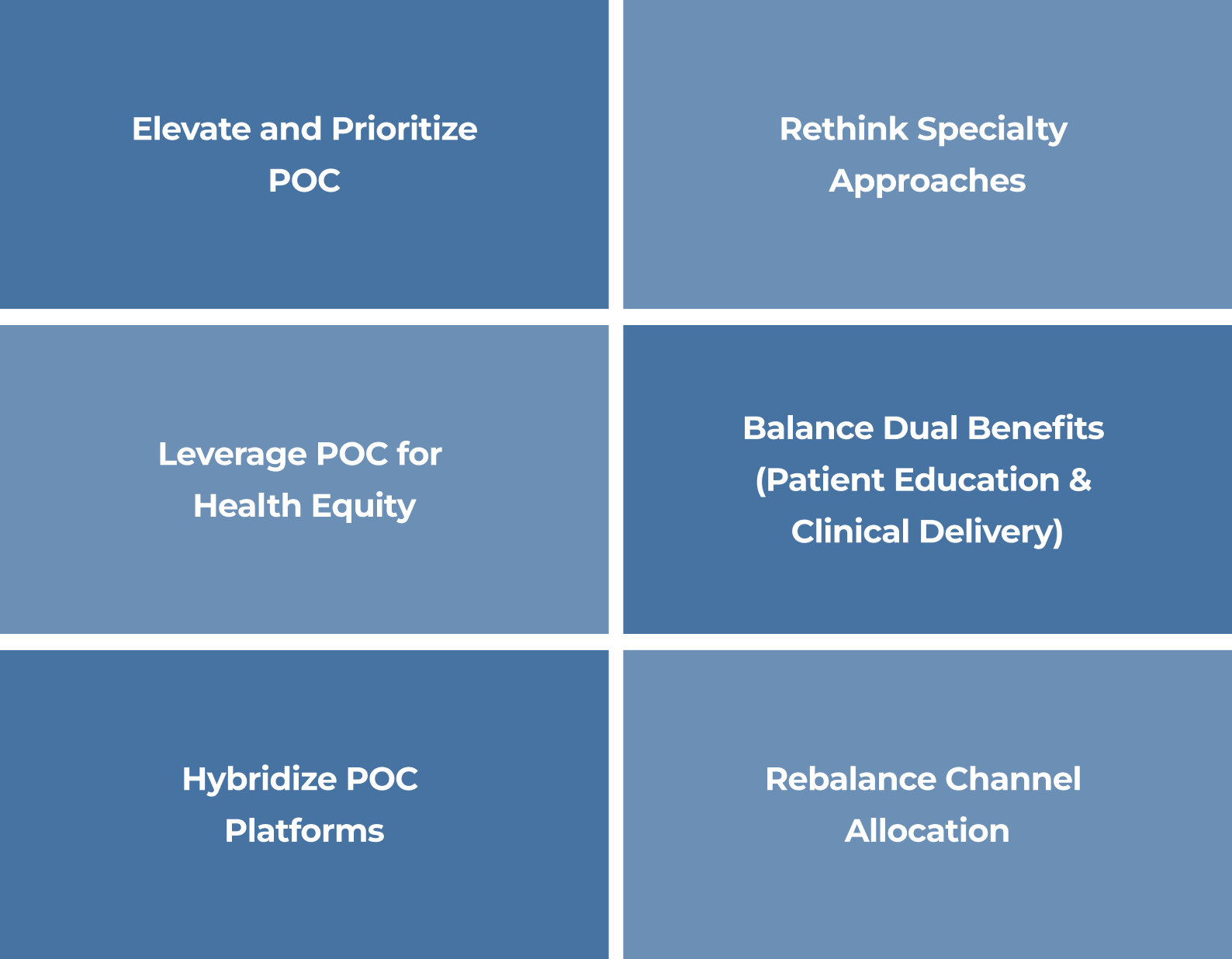
- Elevate POC from Tactical to Strategic
The impact of POC on patient understanding, engagement, and behavior change is too significant to treat as an afterthought. Marketing leaders should prioritize POC early in brand planning, not as a downstream executional detail, but as a central component of strategy that shapes messaging, media, and measurement from the start. - Rethink Specialty POC Approaches
Lower adoption in fields like oncology points to a mismatch between existing solutions and real-world clinical needs. Specialty care environments require POC strategies designed around their distinct workflows, treatment complexity, and provider-patient dynamics. Off-the-shelf approaches won’t suffice; this calls for platforms built with specialty in mind. - Leverage POC as Health Equity Enabler
Engagement data among Black and Hispanic patients shows that POC can do more than educate—it can help close communication gaps that have long contributed to disparities in care. To realize this potential, marketers should create content and delivery strategies that are culturally relevant, demographically attuned, and designed for real impact, not just representation. - Engineer for Dual Benefit
To resonate with providers, POC must offer more than education for patients—it must also support clinical delivery. When positioned as a tool that strengthens provider-patient conversations, clarifies medication discussions, and supports adherence, POC becomes part of the care process rather than an outside message. - Invest in Next-Generation POC Platforms
Providers are asking for formats that are flexible, easy to update, and more responsive to diverse patient needs. The future of POC lies in hybrid solutions that combine the presence and credibility of traditional materials with the customization and adaptability of digital design. - Rebalance Channel Allocation Models
POC consistently ranks among the most trusted and effective channels, yet often receives a fraction of the investment. Marketers should reassess media mix models to reflect where influence truly happens—at the moment of care—and invest accordingly to maximize return and relevance.
With the strategic imperatives clearly outlined, the next challenge is execution. Moving POC from insight to impact requires both shifts in mindset and a data-backed and deliberate alignment of tactics, tools, and measurement. What follows is a practical framework to support that shift, tailored to the distinct roles shaping healthcare marketing today.
Implementation Recommendations
Whether you’re a pharmaceutical brand, agency partner, or healthcare leader working within the practice setting, effective implementation must reflect both the lived patient experience and the operational realities of care delivery. These role-specific recommendations offer actionable pathways to put Point of Care strategy into motion:
For Pharmaceutical Marketers:
- Conduct POC channel audit against behavior change metrics rather than traditional awareness/recall measures
- Develop specific POC KPIs around medication initiation, adherence, and patient-provider conversation impact
- Create specialty-specific POC toolkits that address unique workflow needs of oncology and other complex specialties
- Establish demographic engagement tracking to measure POC impact across racial and age demographics
- Integrate POC solutions with patient support programs to create behavioral follow-through on in-office momentum
For Healthcare Marketing Agencies:
- Develop hybrid POC platforms combining print stability with digital customization capabilities
- Create modular content systems allowing HCP adaptation for patient demographics and literacy levels
- Design POC solutions with dual focus on patient education and HCP workflow enhancement
- Establish POC effectiveness benchmarks using behavior change metrics rather than traditional awareness measures
- Develop demographic variation testing to optimize engagement across racial and age segments
For Practice Implementation Leaders:
- Conduct POC material workflow assessment to identify integration friction points
- Establish cross-functional POC teams including clinical staff and front desk personnel
- Create POC material selection criteria based on demonstrated behavior change impact
- Develop provider training on POC material utilization to maximize time efficiency benefits
Implement patient feedback systems to track POC material impact on understanding and engagement
Conclusion: POC as the Healthcare Marketing Imperative
For healthcare marketing leaders navigating shifting consumer behavior, rising health literacy, and growing pressure to deliver measurable outcomes, the POCMA research presents a clear and compelling case. Point of Care is not merely a viable channel. It is a critical environment for influencing patient journeys and improving health outcomes.
The data reveals more than effectiveness. It positions POC as a uniquely meaningful moment in the care experience where information becomes action, questions turn into conversations, and brand messages drive real behavior change. At a time when marketing success is increasingly measured by tangible health impact, POC stands out as the channel most closely connected to outcomes that matter.
The challenge ahead lies in execution. Bridging the gap between POC’s documented potential and the next-generation solutions needed to unlock it will require strategic foresight, operational alignment, and creative focus. For marketing leaders ready to reimagine their approach, the opportunity is clear: to gain competitive advantage while contributing to a healthier, better-informed patient population.